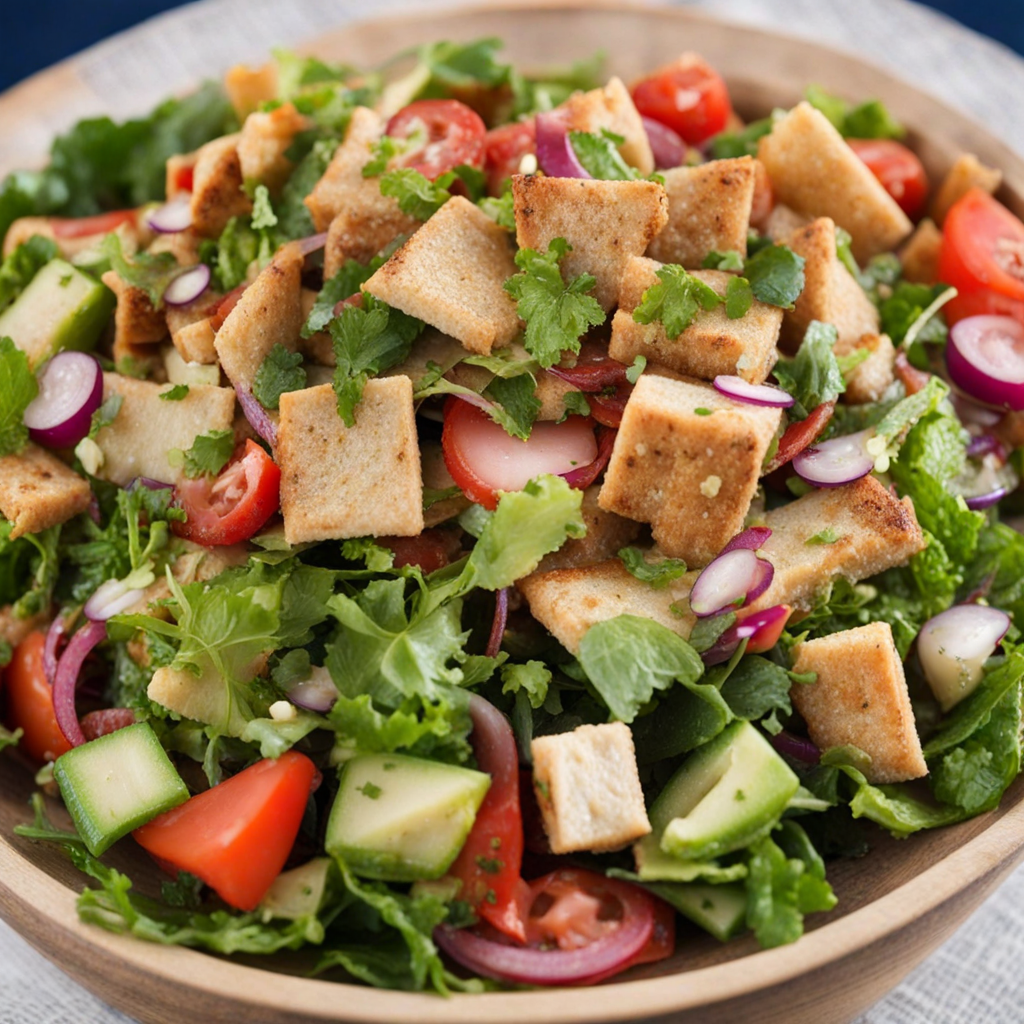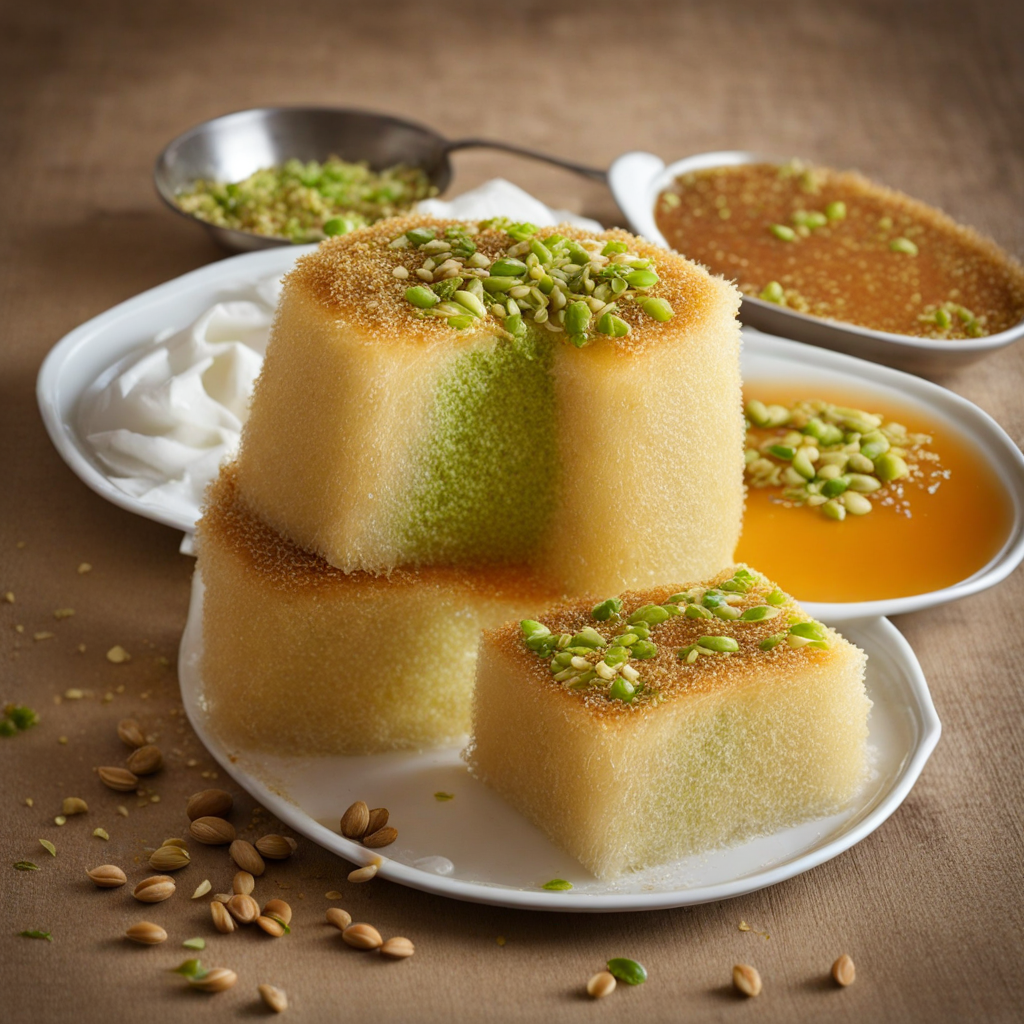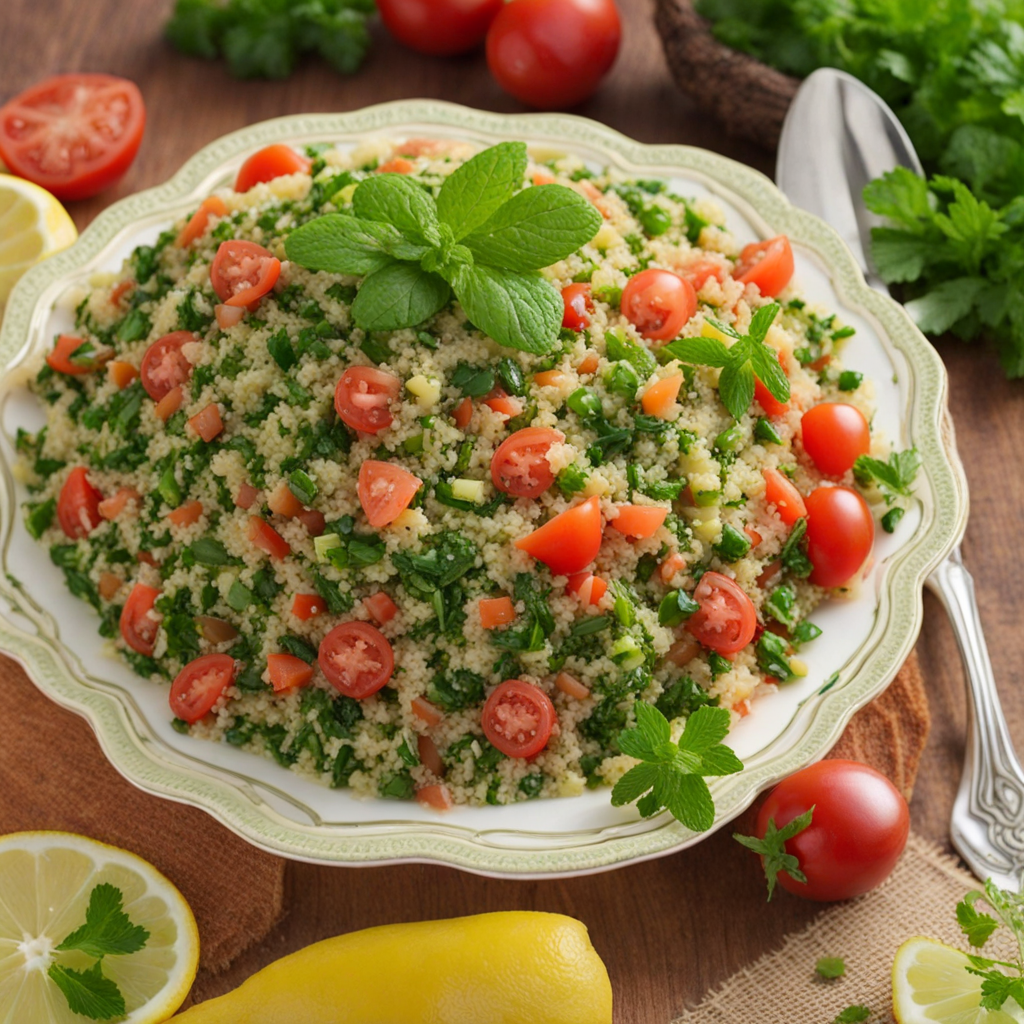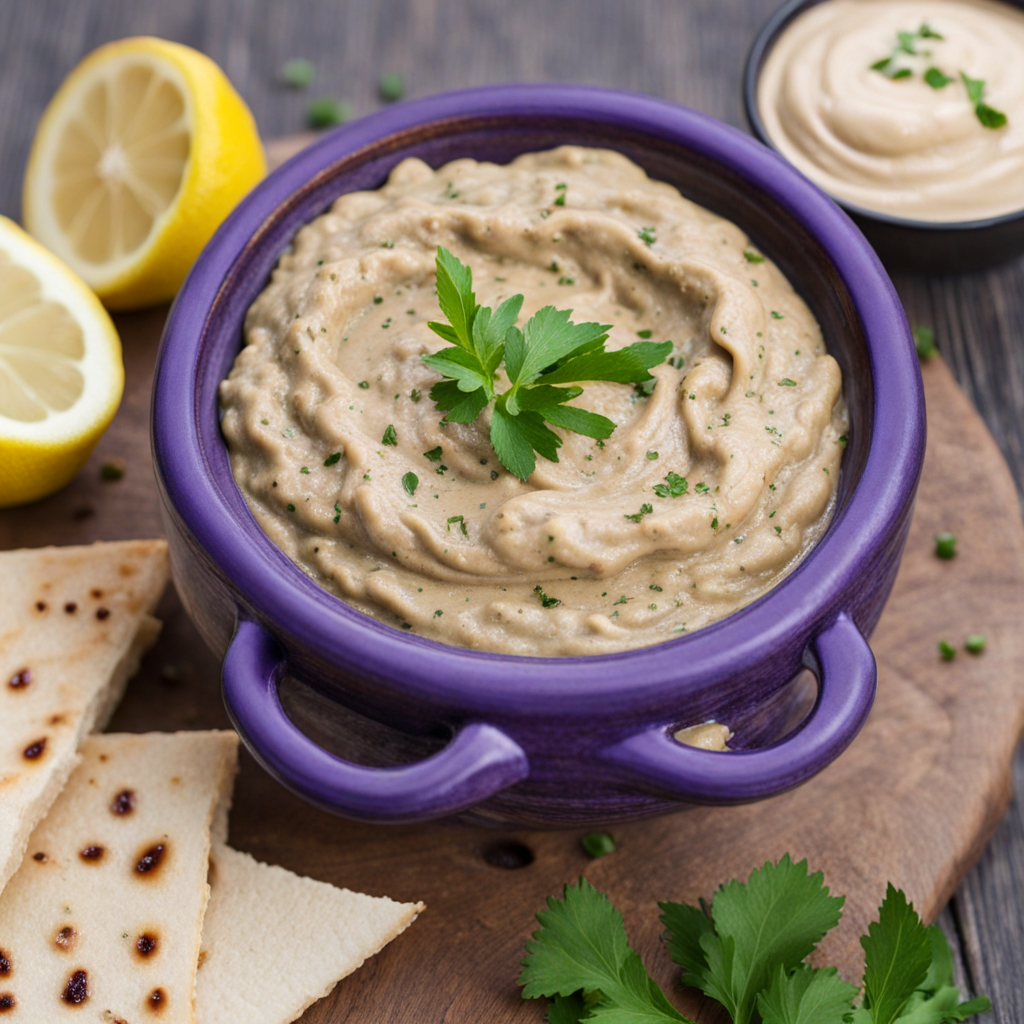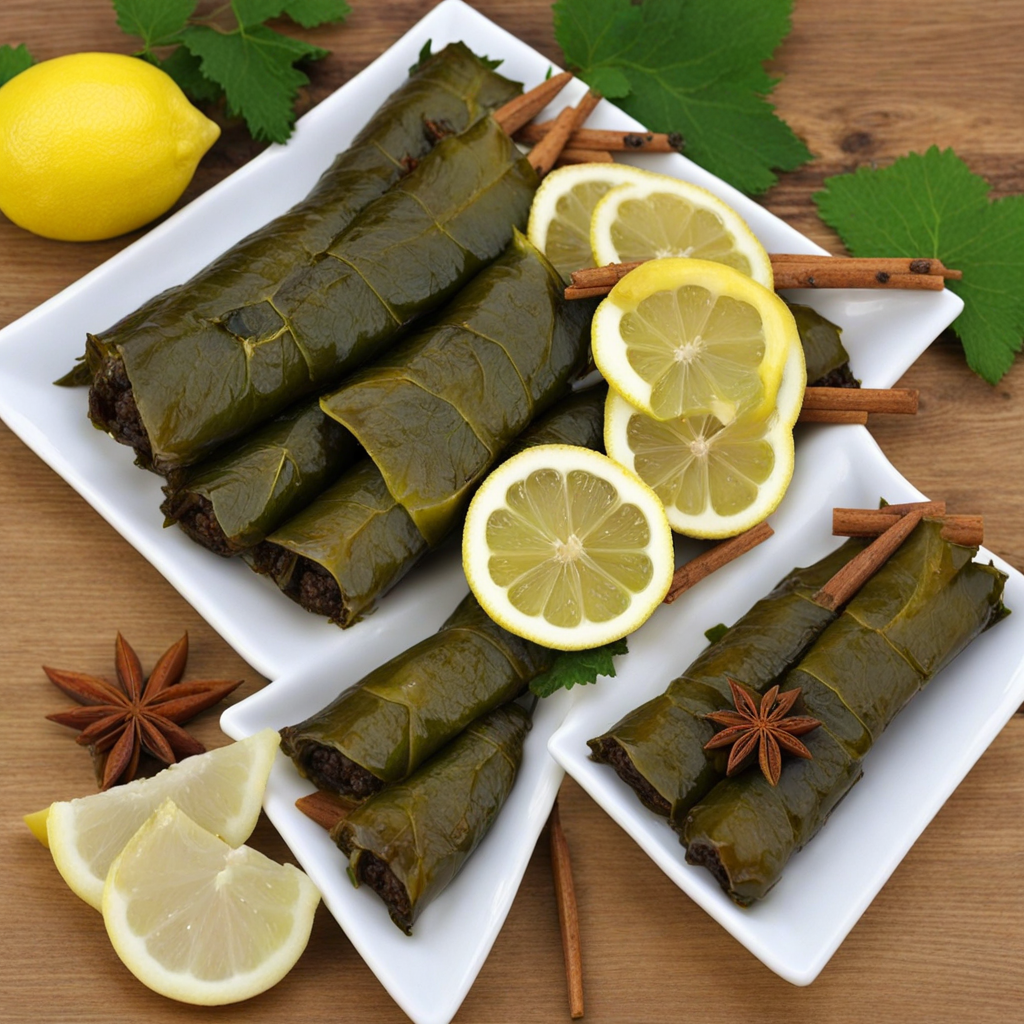Fattoush
Fattoush is a vibrant and refreshing salad that hails from the Levantine region, particularly popular in Syria and Lebanon. This dish is a beautiful mosaic of flavors and textures, primarily featuring crispy pieces of toasted or fried pita bread combined with a medley of fresh vegetables. The base typically includes romaine lettuce, tomatoes, cucumbers, radishes, and green onions, each contributing a crunchy bite and a burst of color. What sets Fattoush apart is its unique dressing, often made from tangy sumac, olive oil, and lemon juice, which adds a zesty kick that elevates the salad to a whole new level. The use of sumac is a signature element in Fattoush, imparting a delightful tartness that complements the freshness of the vegetables. The addition of mint and parsley not only enhances the flavor but also contributes to the salad's aromatic profile. Each ingredient is carefully selected to create a balance of tastes—sweetness from the tomatoes, bitterness from the radishes, and the earthy notes from the herbs. The crispy pita bread adds a satisfying crunch while soaking up the dressing, making every bite a delightful experience. Fattoush is not just a salad; it's a celebration of seasonal produce and culinary heritage. Traditionally served as a side dish, it embodies the essence of Middle Eastern cuisine, where fresh ingredients are key. Whether enjoyed as a light lunch or as part of a larger feast, Fattoush offers a delightful way to explore the rich flavors of Syrian cooking, inviting you to savor the freshness and complexity of every ingredient. Its vivid presentation and tantalizing taste make it an irresistible dish for anyone looking to expand their palate.
How It Became This Dish
Fattoush: A Culinary Journey Through History and Culture Fattoush (فتوش) is not just a salad; it is a vibrant embodiment of Syrian culinary heritage, steeped in history and cultural significance. This refreshing dish, characterized by its crisp vegetables, tangy dressing, and distinctive pieces of toasted or fried bread, has evolved over centuries, reflecting the intricate tapestry of the Levantine region. #### Origins: The Birth of Fattoush The origins of fattoush can be traced back to ancient Levantine civilizations, where the concept of using stale bread as a staple in salads emerged. In a historical context, bread has long been a fundamental component of Middle Eastern diets, often serving as a vehicle for various ingredients. This practice is rooted in the need to reduce waste—a necessity in a time when resources were scarce. Fattoush is believed to have originated in the region of modern-day Syria and Lebanon. The word "fattoush" itself derives from the Arabic verb "fatta," which means "to break into pieces." This signifies the dish's primary ingredient: broken pieces of bread. Traditionally, the bread used is khubz (Arabic flatbread), which is either toasted or fried to achieve a satisfying crunch. #### Cultural Significance: A Symbol of Hospitality and Identity Culinarily, fattoush is more than just a salad; it is a symbol of hospitality and community. In Levantine culture, food is an essential part of social gatherings, celebrations, and familial bonds. Serving a dish of fattoush at a gathering indicates a warm welcome and a desire to share the bounty of the land. The dish's colorful presentation, with an array of vegetables and herbs, reflects the abundance of nature and the art of local farming. In Syria, where the dish is particularly revered, fattoush often features prominently during Ramadan, the holy month of fasting. It is served to break the fast, symbolizing nourishment and the joy of coming together as a family. The combination of fresh vegetables, herbs, and tangy dressing provides a refreshing contrast to the heavier dishes typically consumed during this time. Fattoush also holds a deeper connection to the agricultural practices of the region. The ingredients used in the salad—such as tomatoes, cucumbers, radishes, and mint—are often sourced from local farms, celebrating the seasonal cycle and the connection between the land and its people. This farm-to-table approach is a hallmark of Syrian cuisine, reinforcing the importance of community and sustainability. #### Development Over Time: Variations and Adaptations As Syria's borders have shifted and the region's cultural landscape has evolved, so too has fattoush. The dish has absorbed influences from neighboring countries, resulting in numerous regional variations. For instance, Lebanese fattoush often incorporates pomegranate seeds and sumac, a tart spice that adds a unique flavor profile. In contrast, the Syrian version might emphasize fresh herbs like parsley and mint, showcasing the herbaceous quality of the dish. The rise of globalization and the advent of the internet have also played a significant role in the dissemination of fattoush beyond its traditional boundaries. As Middle Eastern cuisine gained popularity across the globe, chefs and home cooks began to experiment with the ingredients and presentation of fattoush. The salad has been adapted to suit various palates, incorporating ingredients like avocados, quinoa, or even different types of bread. Despite these adaptations, the essence of fattoush remains intact. It serves as a reminder of the region's rich agricultural heritage and the importance of fresh, seasonal ingredients. In modern restaurants, particularly those specializing in Middle Eastern cuisine, fattoush is often featured on menus, showcasing its enduring appeal. #### Fattoush in Contemporary Cuisine In today’s culinary landscape, fattoush has transcended its traditional roots to become a beloved dish worldwide. Its vibrant colors and fresh flavors have made it a favorite among health-conscious eaters and those exploring international cuisines. The salad's versatility allows it to be served as a side dish, a light meal, or even a main course when topped with proteins like grilled chicken or chickpeas. The dish has also found its way into fusion cuisine, where chefs blend elements of different culinary traditions. For example, fattoush-inspired wraps or bowls that include elements from Asian or Western cuisines showcase the dish's adaptability and appeal to diverse audiences. Moreover, as awareness of food sustainability and ethical eating continues to grow, fattoush stands out as an ideal dish that emphasizes the use of local, seasonal ingredients. It encourages minimal food waste—using stale bread instead of discarding it—and highlights the connection between cooking and environmental consciousness. #### Conclusion: Fattoush as a Culinary Heritage Fattoush is more than just a salad; it is a celebration of Syrian culture and a testament to the ingenuity of its people. From its humble origins as a means to utilize stale bread to its status as a global favorite, fattoush embodies the spirit of community, sustainability, and hospitality. As it adapts to new culinary landscapes while retaining its core elements, fattoush continues to honor its rich history and cultural significance. In every bite of fattoush, one can taste the echoes of the past—the farmers who tended their land, the families who gathered around the table, and the traditions that have been passed down through generations. As we enjoy this delightful dish, we are not only savoring a salad but also partaking in a shared cultural narrative that transcends borders and unites us through the universal language of food.
You may like
Discover local flavors from Syria



